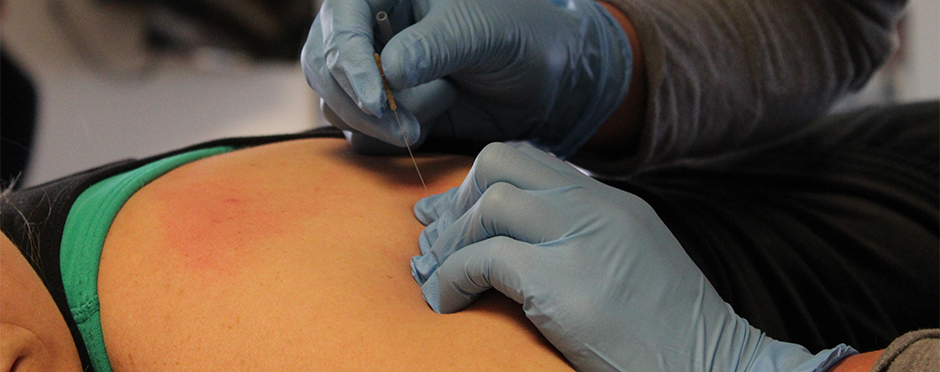
Dry Needling: Runners can Relieve Pain and Continue to Train!
3 CommentsFrom indoor tracks and treadmills, endurance athletes and amateur runners are taking to the beautiful outdoors. As activity levels increase and miles add up, runners may experience pain, weakness, or fatigue, limiting their workout. Whatever the reason, runners can find themselves hitting a wall or plateauing throughout training. Many times symptoms are ignored and athletes push through. With that said, there are effective treatment options that can occur as training continues. One effective treatment for endurance athletes is trigger point dry needling.
Dry needling is a skilled intervention performed by a licensed physical therapist using a thin needle to penetrate the skin and muscle to release underlying muscle myofascial trigger points. These trigger points can result in muscular pain and impaired movement which can be detrimental to running. Dry needling can be very effective in loosening tight tissue and relieving painful muscles that many runners may experience. Based on symptoms, a physical therapist can palpate painful and non-painful trigger points as well as taut bands of tissue in individual muscles. Then, the physical therapist uses the thin needle (similar to an acupuncture needle) to release the trigger point or taut band, allowing muscles to function more properly and with less pain. This release results in improved gait patterns, stronger muscle contractions, and more productive workouts. To fully understand the benefits of dry needling it may be helpful to understand how and why these trigger points occur in the running population.
During unaccustomed exercises, intense exercise, eccentric exercises, or even prolonged submaximal exercises, muscle damage can occur on a microscopic level. It has been proposed that this muscle damage causes an imbalance in the chemical makeup within the muscle fibers and this imbalance results in persistent muscle fiber contraction (1). This persistent muscle fiber contraction (trigger point) and taut band can be a source of pain. These painful “knots” can be characterized as “hyperalgesic”, meaning they have abnormally heightened sensitivity to pain(2). When running, the hips and legs are put through long durations of submaximal contractions. These contractions typically occur when pacing, or participating in speed training or hill workouts. Any of these can factor into the development of trigger points and taut bands. Dry needling releases these taut bands and trigger points and improves the chemical imbalance (3) in the muscle fibers, reducing pain and restoring function.
Runners develop these trigger points in several common areas. Some of the more frequent problem areas include:
- Hip musculature: pain/dysfunction in the thigh, groin, down the side of the leg, and back of the leg.
- Groin musculature: pain/dysfunction in the groin, low back, and pubic area
- Thigh: pain/dysfunction in the thigh and knee
- Hamstring: pain/dysfunction in the hamstring, back of the knee, and upper calf
- Calf musculature: pain/dysfunction in the calf, back of the knee, heel, and bottom of the foot
Addressing these trigger points with dry needling along with a formal assessment of your lower extremity strength, ROM, and mechanics can help return you to optimal performance.
Click to learn more about Dry Needling
Or use the button below to find an Athletico near you that offers dry needling!
The Athletico blog is an educational resource written by Athletico employees. Athletico bloggers are licensed professionals who abide by the code of ethics outlined by their respective professional associations. The content published in blog posts represents the opinion of the individual author based on their expertise and experience. The content provided in this blog is for informational purposes only, does not constitute medical advice and should not be relied on for making personal health decisions.
1. Gerwin RD, Dommerholt J, Shah JP. An Expansion of simons integrated hypothesis of trigger point formation. Current Pain and Headache Report. 2004, 8: 468-475.
2. Nidamm DM, Chan RC, Lee SH, Yeh TC, Hsieh JC. Central Representation of hyperalgesia from myofascial trigger point. NeuroImage. 2008, 39:1299-1306.
3. Shah JP, Gilliams, EA. Uncovering the biochemical milieu of myofascial trigger points using in vivo microdialysis: An application of muscle pain concepts to myofascial pain syndrome. Journal of Bodywork and Movement Therapies. (2008) 12, 371-384.

3 Comments
Brian Whittington
Shad-
Thanks for taking the time to read the article. Please feel free to email me if you have any questions: Brian.whittington@athletico.com
Lev
Great article, I heard that chiropractic methods can be applied too, but can they be combined altogether (chiropractic + Trigger point massage)?
Brian Whittington
Thanks for the reply Lev. Dry Needling can and is used with a variety of other treatment methods. In my practice I use dry needling along with other types of manual therapy techniques to return the patient back to their full function. I also work with other healthcare providers, such as chiropractors, when using dry needling as a treatment. So, yes! Dry needling can be combined with other treatment methods!
-Brian